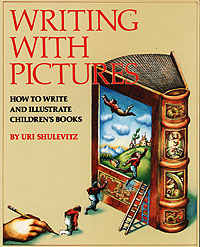Review of Writing with Pictures: How to Write and Illustrate Children's Books by Uri Shulevitz
Contents
| Comments | To Buy
Purple
Crayon Bookstores
Book
Reviews Index Page

|
|
Contents of Writing with Pictures: This is a substantial book, large format, 272 pages, with over 600 illustrations (mostly black and white, many of them small). Shulevitz breaks it down into four sections: Telling the Story, Planning the Book, Creating the Pictures, and Preparing for Reproduction. There is also an appendix with advice on finding a publisher, a short bibliography, and a useful index.
Telling the Story: In this section, Shulevitz opens with the difference between a picture book and a story book. He then goes on to explain his theory of "visual storytelling," using many visual examples. Story at its most basic involves change, and he shows how this plays out in illustrations. He also demonstrates how text and illustration work together in a picture book, and closes with a discussion of the characteristics of a picture book, such as "linear continuity" and rhythm and repetition.
Planning the Book: In this section, Shulevitz shows the steps an illustrator goes through to create a book: starting with a story board; moving on to a dummy; working with text in a layout; playing with many possibilities of size, scale, shape; and dealing with the structure of a printed book. Step-by-step visual illustrations make this easy to follow. Shulevitz includes examples that show how he worked on books he illustrated.
Creating the Pictures: This section starts with theory: the purpose of illustration is to clarify or even illuminate the text, and thus the illustrator must at least make the pictures "readable." He then focuses on creating illustrations themselves. It covers such topics as drawing figures and objects, using visual references, composition, technique, and style, with copious examples.
Preparing for Reproduction: This section has become badly dated, as it focuses on the way to create pre-separated art, which used to be the predominant method used in children's books to prepare illustrations for the printing process. Today, of course, art for almost all picture books is created entirely or partially digitally, though some illustrators still work with physical media. Neither digital art (which is delivered as digital files) or physical art (which is scanned and turned into digital files) needs to be pre-separated.
Comments: It's not over-praising this book to say that there's no other book like it, and that it's an unmatched resource for anyone involved with children's book illustration. I've had a copy for several years, and I learn something every time I open it. Of course, I'm an editor, but the illustrators I know tell me the same. That may explain why no other book has come along to replace it.
If you want to understand the nitty-gritty of creating a picture book, from text to final illustrations and layout, the full theory and practice of picture books, there is no other book out there. Shulevitz also provides guidance for other kinds of books, and covers many aspects of illustration. For a more recent book with a wider focus, see Martin Salisbury's Illustrating Children's Books is a 2004 introduction to the field, but doesn't go into the same depth.
Books by Shulevitz used as examples: Shulevitz mentions and reproduces illustrations from many books, but two of his books in particular appear when he discusses various stages of the process of developing a picture book: Dawn and One Monday Morning. Get a paperback copy of one or both of them--they're great books, worth having on their own, and being able to see how one of them turned out will further enrich your understanding.
Who Needs Writing with Pictures: Anyone who either wants to be a children's book illustrator or already is needs to have this book--if you don't have it already; children's book writers and children's librarians (and other children's books professionals) will also find that their understanding of picture books and of illustrated children's books more generally will be deepened by studying Shulevitz's approach. If you seek a broader, somewhat more up-to-datefocus, get a copy of Martin Salisbury's Illustrating Children's Books too.
More recommended books, magazines, and web sites (The complete Resources section from my Complete Idiot's Guide)
Where and How to Purchase Writing with Pictures (online):
- Buy Writing with Pictures at Amazon. Still in print as a paperback, and there are used copies at reasonable prices.
- Buy Writing with Pictures at Amazon Canada, if you live in Canada.
This review is copyright © by Harold Underdown ( Google + Profile ). If you wish to reproduce it, please see the Terms of use. Last modified 11/11/2024.